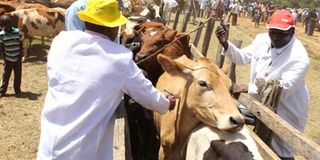How to ensure milk is free of chemical residues

Veterinary officers vaccinate cows in Uasin Gishu during World Veterinary Day on April 26 last year. FILE PHOTO |
What you need to know:
- Eating of animal products exposed to chemicals can result to allergic reactions.
- Farmers need to ensure that the environment the animal lives is clean and well-aerated.
Antibiotics are drugs widely used in the treatment of most animal diseases. After the treatment, many farmers have to deal with residues, which are remnants of the drugs or their active metabolites that are present in tissues or products such as meat, milk or eggs.
During the treatment period and even days after treatment, the residues are shed in animal wastes and products.
This can be attributed to failure to observe the withdrawal periods, incorrect dosage, and illegal or extra label usage of the drug.
Non-restrictive usage of antibiotics in animal rearing may lead to problems due to the presence of harmful residues.
Development and spread of antibiotic resistance represents a serious threat with potential public health implications.
Dissemination of resistance traits could narrow the line of defence against bacterial infections to only a few antibiotic agents, thus, increase health care costs.
Eating of animal products exposed to chemicals can result in allergic reactions, toxicity, carcinogenic effects although the validity of some of the reactions is sometimes debated.
Penicillins as well as antibiotics such as cephalosporins and carbapenems could cause allergies if high levels of residues are in milk consumed. Tetracyclines residues also have the potential to stain teeth of young children.
Antibiotic residues in milk are undesirable from a manufacturer’s perspective, as they can interfere with starter culture activity and hence disrupt the process.
The dairy starter cultures currently used in the country for the primary acidification of the milk belong mainly to the genera Lactococcus, Streptococcus, Leuconostoc and Lactobacillus.
These cultures are used in production of cheese, yoghurt, cultured butter and milks. The sensitivity of starter cultures to antibiotic substances present in milk also varies considerably.
CONTROLLING ANTIBIOTIC RESIDUES
When you have a sick animal, seek the help of a qualified veterinary officer to ensure that you get relevant information about the drug and treatment procedure.
Read the drug labels or ask for interpretation of the instructions on the withdrawal period, which is the time until all toxic and harmful substances have been cleared from the animal’s body (including from meat and milk) of the treated animal.
Observing the instructions is important and should be accompanied by keeping of simple records for individual animals on the farms to ease tracing histories.
This will make it easier for a particular vet to track the health history of an animal. These simple steps may just save lives, our animals and help conserve the environment.
Farmers also need to ensure that the environment the animal lives is clean and well-aerated. Personnel handling animals should observe high standards of hygiene.
Joy is a member of the Dairy Team, Egerton University.




